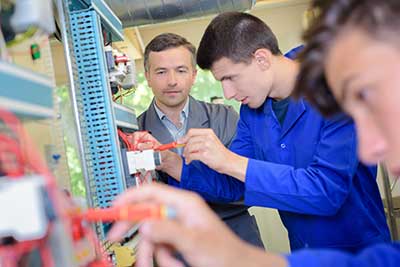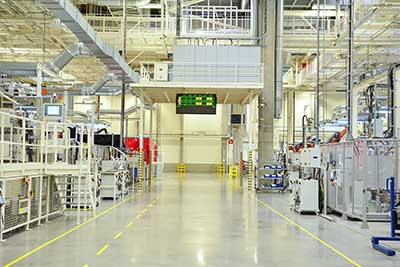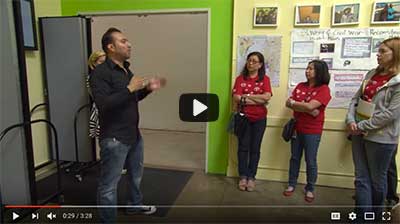
Genchi genbutsu is a Japanese term that means "go and see." Like many manufacturing and production concepts, it comes from the Toyota Production System. To put it simply, this concept teaches that to understand what is going on in a facility and make sure everything is happening the way it is supposed to, the leadership team needs to go and see for themselves.
Following the Production
There are many ways that people can go and see what is happening in a facility. One of the most effective options is to follow the production of a product from start to finish.
Having a manager start in the receiving department and see how all the parts and inventory arrive, then following those parts to the production line until the product is completed, and finally seeing them shipped off, can be very helpful. For some facilities, this activity may need to be done in small chunks, but getting this type of knowledge is essential to managing the facility properly.
Who Goes to See
When most managers learn about genchi genbutsu, they believe they won't have enough time in a day to go out and see all the different areas regularly. If this isn't done, though, it will end up costing the leader a lot more time in the long run because they will have to deal with problems that arise over time. Leaders aren't, however, the only ones who need to go out to the location where the work is done.
Different people should be assigned to go out to locations for different reasons. Understanding the specific reasons why people go and see a facility is essential for the effective implementation of genchi genbutsu.
Leaders Go Themselves
As mentioned above, the leaders of a facility need to go and see what is going on in the facility so they have firsthand knowledge. This should include leadership at all levels of the organization from the CEO to the direct supervisor. There are many benefits for the facility when the leaders take on this responsibility:
- Direct Oversight - The leaders don't have to rely so heavily on the word of others, which can often be a watered-down version of the truth. There is absolutely no substitute for going and seeing with their own eyes.
- Support from Employees - Having the leadership team, especially upper-level leadership, come and see how the work is done can help employees feel more dedicated to their work.
- Insights - Seeing how work is done in a facility can give leaders additional insights into what can be improved.
Delegates Go for Leaders

Depending on the size of the facility, leaders may also want to delegate people to go and see on their behalf. When doing this, the most important thing to remember is to avoid having someone go out and see who also works in the area being inspected. For example, if a CEO wants to send someone to "go and see" the shipping area, they should never send someone who works in that area, especially not a supervisor of that area.
The CEO can either have one person whose whole job is to go and see on their behalf, or else use members of one department to go and see another. This is important because a leader can't count on one department to closely critique itself.
One of the benefits of being able to go and see is that it brings in an outside perspective. Even if a department supervisor is entirely honest and dedicated to improvement, it would be nearly impossible for them to benefit from this process as much as someone who doesn't work for that part of the company.
Core Genchi Genbutsu Elements

One other category of people who should go and see things in the facility is new employees. Many companies make the mistake of bringing new employees to the area where they will work and never showing them the full facility. In fact, in many implementations of genchi genbutsu, it is the employees who are the primary target of this strategy.
Even if someone's job only requires them to be in one small area, they should be given a full and comprehensive tour of the entire facility. Showing each new employee all areas and explaining what is done in each area will give them a much better picture of how their role fits into the whole company. It can also give them ideas of what other jobs they may want to try in the future.
Many companies even bring employees around to different areas of the facility at least once per year to help ensure they know what is going on. Letting people see how their jobs fit into the company as a whole can be very helpful.
Employees who have been in the facility for a while can use this strategy too. If someone halfway down the manufacturing line notices there is a problem with one type of part they are receiving, genchi genbutsu teaches that they should go to the source of the problem. This may be the previous workstation in the production line.
Once there, they can identify what is going wrong and work with that group to get it fixed. This process is not about placing blame, but rather about identifying ways a facility can improve and working together to accomplish that improvement. For many facilities, this is best done at the front-line employee level and only escalated to management when necessary.
Making Genchi Genbutsu Visual

The main goal of going and seeing what is taking place in the facility is to remain educated about how things happen and be able to make improvements. When going and seeing a facility, however, it can be a great opportunity to make it a more visual workplace.
Many people will bring with their signs, floor markings, and other visual tools when performing genchi genbutsu. Using these visual cues can make the next genchi genbutsu more productive because they will provide some guidance. Labeling areas where there is a concern, putting floor signs where specific tasks are done, and any other type of visual communication can be very helpful.
Some facilities even bring a portable industrial label printer along with them to create labels that can be used in the future. This is a simple way to make the process of going and seeing even more effective.
Choosing the right tools for making visual improvements based on what is found during genchi genbutsu is very important. When done correctly, the act of "going and seeing" can improve safety, reduce waste, and generally help the facility run more efficiently.
Observing is Essential
It is important to remember that genchi genbutsu is not just a walkthrough of the shop floor. It requires that the person going and seeing takes the time to really observe everything that is going on.
In fact, one of the originators of the genchi genbutsu concept is known for taking people to the shop floor and telling them to stand in an area that has a chalk circle in it. They are then instructed to stay in that circle and take notes about everything they observe. When he came back, the man would review the notes taken. If the person didn't observe enough, they would be required to remain in the circle for additional time.
There are certain things that simply can't be grasped in just a couple of minutes. For example:
- Patterns - When observing how people work, it can take a significant amount of time to recognize the patterns that exist. When someone rushes through the area, it is impossible for them to even grasp the patterns of work, much less evaluate whether or not they are effective.
- Full Jobs - Many tasks in a facility can take quite some time to complete. Welding a part, for example, may require several minutes of welding in multiple spots. If the observer doesn't take the time to not only watch the entire process, but watch it being done multiple times, they are almost certainly going to miss some important information.
- Problems - One can often learn more from observing situations when something goes wrong than when everything is running smoothly. Observing an area for an extended period of time creates more opportunity for seeing situations where not everything is running as it should.
- Relaxed Employees - When people are being observed, they typically make an extra effort to ensure they do each step properly. If they are observed for an extended period of time, however, they can become more relaxed and conduct the job like they normally would. This is the ideal time to gather information about what is actually happening in the facility.
Understanding how long to observe an area can be difficult. It will depend largely on what is being done and whether or not there are known problems with the area. Some places can be observed for just 10-15 minutes. Others should be observed for multiple days at a time to really get a good feel for what is happening.
In-Person vs. Digital Observation
There is some debate in the manufacturing world about whether it is strictly necessary for a manager or other person performing genchi genbutsu to actually go out and see for themselves, or if they can have security cameras in place to monitor from a distance.
Using cameras makes it possible to perform the observation from anywhere and it can be done at any time. This helps ensure the work being observed is how people always work, which is a good thing. On the other hand, installing cameras for observation can create a culture of mistrust and also comes with additional expense.
It is important to go and see in person at least much of the time. When actually going out to the shop floor, it creates opportunities for direct communication with the people on the floor, which is invaluable. In some situations, it may also be beneficial to install cameras, but it should only be done after careful thought and weighing the pros and cons.
The Gemba Attitude
Genchi Genbutsu is also referred to as the Gemba attitude, but these two strategies are different. Gemba, translating to mean ‘the real place’ in Japanese, is the managerial practice of visiting the shop floor, talking to line operators and assembly workers, and seeing where the real value is created on the production line. Managers and leaders taking a Gemba walk around their facility should look for real examples of Muda, Mura, and Muri and identify how to reduce or eliminate these wastes. While the goal of a Gemba walk is to see issues and fix them, genchi genbutsu is a strategy to create consensus for a common goal.
Not Just for the Facility
While most of the focus of genchi genbutsu will be on making improvements within the facility, that is not the only way this strategy can be helpful. Taking employees out to see where the products they make are actually being used can also help a facility in many ways.
For example, if a company makes riding lawn mowers, it may be helpful to have front-line employees and supervisors go out and spend a day with a lawn services company. Watch how their products are used and what improvements might be possible. This can give the team ideas for what changes they might be able to make to add more value.
Without going and seeing, the company may never even discover there is an improvement opportunity. While it is not possible to go out to each place where products are used, it is a valuable effort to do it at least occasionally. Even if a company makes a very common product that most people have used, finding people who use it differently and talking to them can be very helpful.



